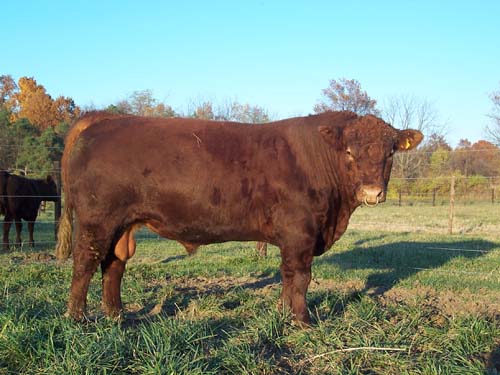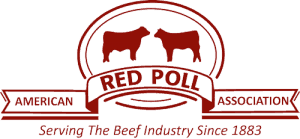 A young Red Poll bull exhibiting great length, muscling and refinement that marks the breed.
A young Red Poll bull exhibiting great length, muscling and refinement that marks the breed.The modern Red Poll breed was developed by combining two relatively pure landrace strains of cattle on the East Coast of England. The Suffolk cattle were a small, reddish colored, polled breed of cattle that had been developed over the generations as a dairy breed. The Norfolk cattle were small red and white, horned cattle developed primarily as a beef breed. The two strains of cattle had been developed from native cattle of the regions. The origins of the native cattle have been lost in the mists of time, but historians suggest that red cattle were brought to Great Britain by both the Romans and the Vikings.
Rev. Arthur Young, in his book The General View of Agriculture of the County of Norfolk, published in 1794, wrote this description of the Suffolk cattle: “This breed is universally polled, that is without horns; the size small, few rise when fat to above fifty stones (700 pounds). . . . If I were to describe the points of certain individuals . . . a clean throat with little dewlap; a thin clean snake head; thin legs; a very large carcase; ribs tolerably springing from the centre of the back but with a heavy belley; backbone ridged; chine thin and hollow; loin narrow; udder large, loose and creased when empty; milk-veins remarkably large, and rising in knotted puffs to the eye . . . many of these beasts will fatten remarkably well; the flesh of a fine quality; and in that state will feel well enough to satisfy the touch of skillful butchers. The best milkers I have known, have either been red, brindle, or yellowish cream coloured . . . the quality of milk is very considerable indeed.”
 Marshall, in 1782 wrote this about the Norfolk cattle: (as quoted in the Red Polled Herd Book, vol 1, American ed., 1891): “a small, hardy, thriving race; fattening as freely and finishing as highly at three years old as cattle in general do at four or five. They are small boned, short legged, round barrelled, well-loined, thin-thighed, clean chapped; the head, in general, fine, and the horns clean, middle sized and bent forward; the favorite colour a blood-red with a white mottled face . . . and if the London butchers be judges of beef, there are no better beasts sent to Smithfield market. The two qualifications, namely the superior quality of their flesh, and their fattening freely at an early age, do away with every solid objection to their size and form.”
Marshall, in 1782 wrote this about the Norfolk cattle: (as quoted in the Red Polled Herd Book, vol 1, American ed., 1891): “a small, hardy, thriving race; fattening as freely and finishing as highly at three years old as cattle in general do at four or five. They are small boned, short legged, round barrelled, well-loined, thin-thighed, clean chapped; the head, in general, fine, and the horns clean, middle sized and bent forward; the favorite colour a blood-red with a white mottled face . . . and if the London butchers be judges of beef, there are no better beasts sent to Smithfield market. The two qualifications, namely the superior quality of their flesh, and their fattening freely at an early age, do away with every solid objection to their size and form.”
In the early 1800’s, John Reeve, a tenet on the Earl of Leicester’s Holkham Estate in Norfolk, began mating his Norfolk cows to Suffolk bulls. Reeve and other breeders of the era selected cattle for both beef and milk production. Reeve’s improved cattle became known as “The Red Polled Cattle Descended from the Norfolk and Suffolk Red Polled.” The small red cattle with the big name gained popularity as improved cattle and were recognized as a separate breed in 1846.
The Red Poll Herd Book was one of the earliest purebred cattle registries in England. Henry Euren an English agricultural writer published the first Red Poll Herd Book in 1874. Using farm and estate records, Mr. Euren was able to gather pedigrees of the foundation cattle of the breed, recreating accurate records back to the beginning of the breed.
 Red Poll cattle were first imported to the United States in 1873 by G.F. Tabor of New York, as recorded in Volume 1 of the Original Series. Between 1873 and 1900 about 300 head of Red Poll cattle were imported into the US and it is from these cattle that the breed in the US developed. Volume II of the Red Poll Herd Book, American Series, recorded pedigrees of 504 bulls and 961 cows in 27 states.
Red Poll cattle were first imported to the United States in 1873 by G.F. Tabor of New York, as recorded in Volume 1 of the Original Series. Between 1873 and 1900 about 300 head of Red Poll cattle were imported into the US and it is from these cattle that the breed in the US developed. Volume II of the Red Poll Herd Book, American Series, recorded pedigrees of 504 bulls and 961 cows in 27 states.
Red Polls defied the cattle depression of the 1890’s, as the demand for these cattle grew. During the 1920’s more than 6,000 head were registered annually. During the Depression, registrations declined to 1,100 in 1937. Registrations rebounded to about 5,000 in the 1950’s.
During the 1950s and 1960s the breed went through a period of transition – moving from being a “dual purpose” breed to being a single purpose, beef breed. The transition was considered complete and in 1972 the breed was of ficially declared a beef breed.
Red Poll cattle continue to thrive today on many American Family Farms; some of which have owned Red Polls for 4 or 5 generations. The population of Red Poll cattle is concentrated in the Mid-West, with herds thriving in the Endless Mountains of Pennsylvania, the Piedmont of North Carolina and the Washington Pacific Coast. There is renewed interest in the breed as both a Heritage breed and as a breed that can produce Choice quality carcasses on grass only.
